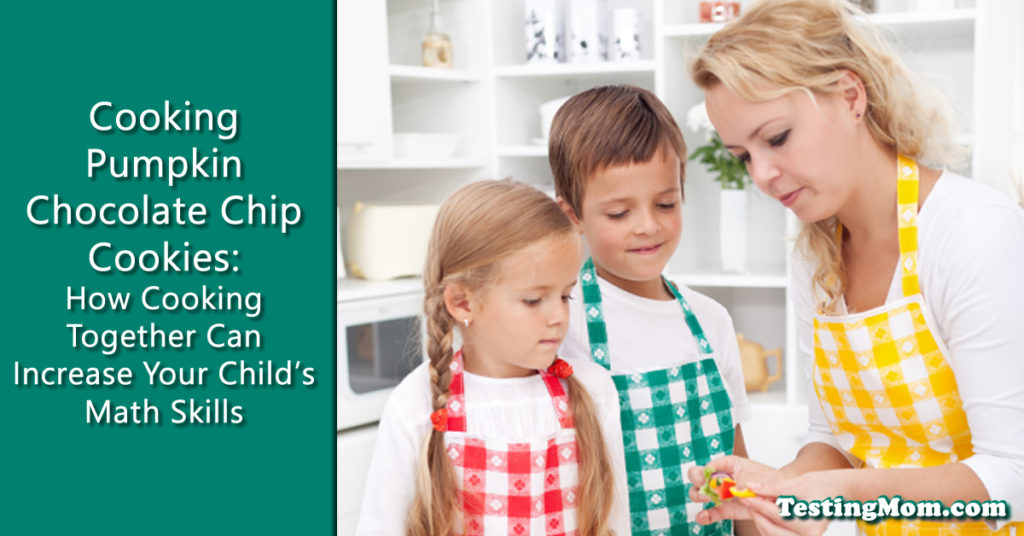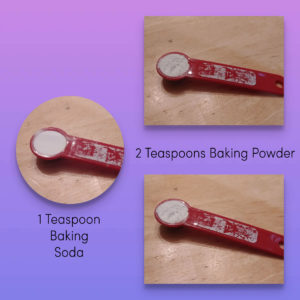› Cooking with Your Kids: How Cooking Together Can Increase Your Child’s Math Skills
Cooking with Your Kids: How Cooking Together Can Increase Your Child’s Math Skills
posted by Karen Quinn, The Testing Mom - October 8th, 2017
Let’s Make Pumpkin Chocolate Chip Cookies Together!

Today on the blog we will be delving into the exciting world of cooking and numbers. Baking and/or cooking is a cognitively engaging activity that combines tactile exploration with literacy and quantitative learning. Spending just a little time in the kitchen each week can be an excellent tool when it comes to preparing for math sections of the CogAT, ITBS, and OLSAT tests (just to name a few). The recipes that you choose with your child, as well as the skills reinforced, can be customized to the child’s age, and or grade level.
For example, if your child is in the process of learning fractions, provide him with a visual representation! Get out the liquid measuring cups so that he can see that 1/4 cup is half of a 1/2 cup. Tools such as measuring cups are valuable when it comes to volume relativity. Once he sees this example, continue the discussion on fractions. Ask him to compare 2/3 of a cup of water (or any of his favorite liquids) to 3/4 of a cup of water. After visually seeing the difference, have your child report which measurement is greater and which is less. If the child is older, he may be focusing on conversions such as the number of ounces in a cup, or the number of pints in a quart. Like the previous fraction example, cooking tools serve as excellent visuals. After repeatedly seeing these conversions within the context of cooking, your child will be more likely to access such calculations without the help of a visual aid.
Some Tips and Tricks!
- Start with baking! Baking encompasses a wide variety of quantitative skills such as addition, subtraction, fractions, and division. Not to mention, it is also great when it comes to integrating the use of teaspoons and tablespoons.
- Let your child take the lead! Get out your favorite cookbook, or take to the internet. Pinterest has an excellent assortment of recipes that are geared towards kids. Many of them have clear visuals and straightforward instructions!
- Follow directions. Cooking is an excellent way to reinforce your child’s ability to follow directions. It may be helpful for your child to read each step aloud. This way he or she can focus on each component of the recipe. Some children may even feel more comfortable writing out the entire recipe in terms that they better understand. The more accessible the recipe the better!
- Mistakes happen. Like all learning experiences, errors are likely to be made when something is foreign or new. Cooking is a science and is very much skill based. A common mistake that is often made when cooking is understanding the difference between measuring solids and liquids. Ingredients such as flours and sugars require dry measuring cups, while oils, milk, and water call for liquid measuring cups. This is because there is quite a bit of variation between liquid and dry measurements.
Here’s the recipe for Pumpkin Chocolate Chips Cookies
Now that we have established the cognitive benefits of cooking, I want to take you through a fun but simple recipe. In honor of the fall season we will be baking pumpkin chocolate chip cookies. As I enumerate each step of the recipe, I will provide you with a corresponding teaching point. Together we will learn how to extract a rich quantitative lesson from a fun and tasty recipe!
Ingredients:
- 1 cup sugar
- 1 tsp vanilla
- 1 egg
- 1/2 cup vegetable oil
- 2 tsp cinnamon
- 1/2 tsp salt
- 2 tsp baking powder
- 1 tsp baking soda
- 2 cup flour
- 8 oz semi-sweet chocolate chips
- 1 small can pumpkin
Step 1
Start by sitting down with your child and looking at the recipe. Review the ingredient list and make sure that they are comfortable with what is required. Encourage them to start by gathering the cooking tools. If the child is younger, you can assist them with navigating the kitchen. Regardless, it is always helpful to be there for support!
Step 2
If your child is new to cooking, explain that the dry ingredients are always prepared separately from the wet ingredients. This step is essential when it comes to infusing structure into the recipe.
Step 3
Now it’s time to prepare and mix the dry ingredients
 2 cups flour: Ask your child whether you should use a dry or liquid measuring cup. Once they choose the dry cup have them measure out two cups (one at a time). If your child is older, present them with a challenge. Ask them how many ounces are in a single cup.
2 cups flour: Ask your child whether you should use a dry or liquid measuring cup. Once they choose the dry cup have them measure out two cups (one at a time). If your child is older, present them with a challenge. Ask them how many ounces are in a single cup.
1 cup sugar: If we used 2 cups flour, then one less cup would be the amount of sugar that we need. Have them subtract one cup from those two cups of flour. They should come to the conclusion that we are left with a single cup!
 2 tsp baking soda and 1 tsp baking powder: Ask your child which ingredient out of the two we need more of. Next, ask them which is greater: a tablespoon or a teaspoon. This is an extremely important concept in baking. Try explaining to them that 3 small teaspoons make up a single tablespoon. This may put things into perspective for them!
2 tsp baking soda and 1 tsp baking powder: Ask your child which ingredient out of the two we need more of. Next, ask them which is greater: a tablespoon or a teaspoon. This is an extremely important concept in baking. Try explaining to them that 3 small teaspoons make up a single tablespoon. This may put things into perspective for them!
1/2 tsp salt: Now that your child has used 1 teaspoon, they are already at an advantage. Ask them whether the 1/2 teaspoon of salt is less than the 1 tsp of baking powder we used previously. Explain to them that if we wanted to use half of the amount of salt, we would only be left with 1/4 tsp of salt. Even if they don’t yet understand this, the exposure to these ideas are valuable
2 tsp cinnamon: Have your child carefully measure out this amount using a teaspoon.
Step 4
Wet Ingredients: Now we move to the wet ingredients. Explain to your child that we will need to add one more bowl.
1 tsp vanilla: At this point your child may be an expert when it comes to measuring out tablespoons and teaspoons.
1 egg: Out of curiosity, ask your child to guess whether the egg yolk would fit better into a teaspoon or tablespoon measure. This will help them to mentally retrieve their past knowledge of the sizing of a teaspoon versus a tablespoon. If they are unsure, explain to them that the size of the yolk would more closely fit into a single tablespoon.
1/2 cup vegetable oil: Remind your child that we now switch to a liquid measuring cup. Have them measure out a cup. Let them observe the other fractions that are included on the side of the cup.
1 small can pumpkin: For practice, have your child pour the pumpkin puree into a liquid measuring cup. Have them measure and read the side of the cup. Have them report back to you the exact volume of the pumpkin.
Step 5
Mix, mix, mix: Have your child mix the wet ingredients into the dry before mixing with a spatula. Let them tell you when they think the ingredients are fully absorbed.
Step 6
Fold in 8 oz chocolate chips: This is a tricky step. At first your child may be unsure of what 8 oz means. Give them a hint by telling them to reference the measuring cup. They should find a label that says 8 oz on the side of the cup. Explain to them that 8 oz is the same as 1 cup. Finally gently fold in the chocolate chips.
Step 7
Let batter sit for 20 minutes.
Step 8
Once this step is complete, explain to your child that you must preheat the oven. This way it will be hot enough to bake the cookies. In this case have them help you set the oven to 350 degrees.
Step 9
Lastly, scoop cookies. Ask your child how many tablespoons make up a single cookie. They should come to an answer by looking at the number of tablespoons that are required for scooping a cookie.
Step 10
Bake your cookies for 10 minutes! When the time is up, take your cookies out and allow them to sit. Enjoy your delicious fall treat with your child!

I hope this post helped to inspire you and your child to have fun in the kitchen! Of course, these are just examples of dialogue that you can start introducing to your child. Depending on your child’s age or skill level, it is best to introduce these ideas slowly. There is absolutely no rush. The most important thing is to have fun, and to allow your child to be intrigued by the concepts. Cooking can be an excellent way to spend time with your child while learning. Plus, it doesn’t hurt that the reward is a tasty treat!
For your own reference, the full recipe for the pumpkin cookies is posted below. Happy baking!
http://www.thejennyevolution.com/soft-pumpkin-chocolate-chip-cookies-recipe/



Tell us about your experiences
One Response
Monica
This blog post shows a concrete way of blending fun, extending literacy skills, spending quality time, and of course – developing number sense. Glad I read it right before Thanksgiving so will put this into practice today :). Also, baking a cake with your child and slicing it into equal slices at the end will probably them another great visual about fractions and improve their understanding about them. Thanks for posting!